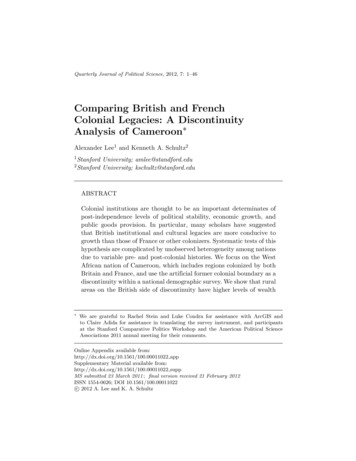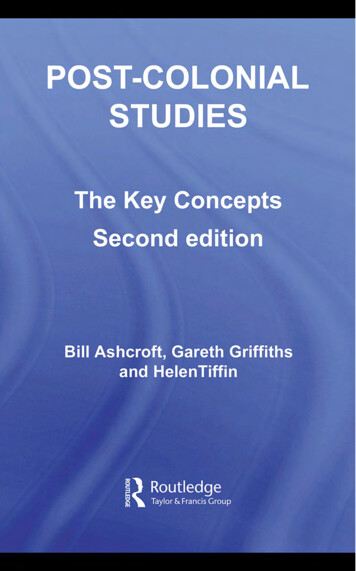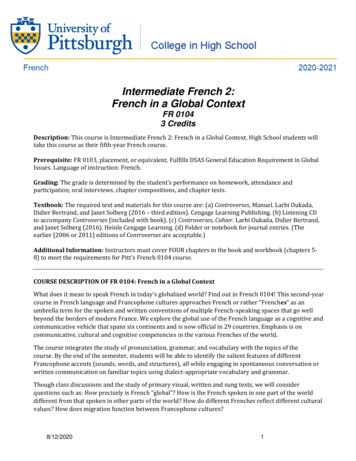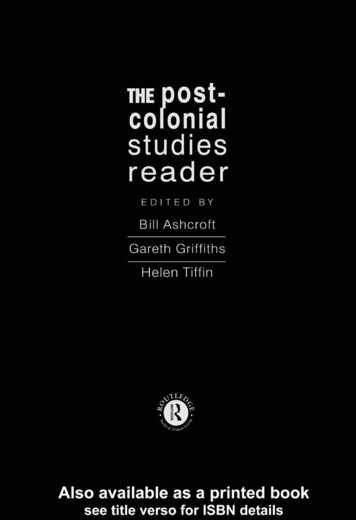
Transcription
Quarterly Journal of Political Science, 2012, 7: 1–46Comparing British and FrenchColonial Legacies: A DiscontinuityAnalysis of Cameroon Alexander Lee1 and Kenneth A. Schultz21 Stanford2 StanfordUniversity; amlee@standford.eduUniversity; kschultz@stanford.eduABSTRACTColonial institutions are thought to be an important determinates ofpost-independence levels of political stability, economic growth, andpublic goods provision. In particular, many scholars have suggestedthat British institutional and cultural legacies are more conducive togrowth than those of France or other colonizers. Systematic tests of thishypothesis are complicated by unobserved heterogeneity among nationsdue to variable pre- and post-colonial histories. We focus on the WestAfrican nation of Cameroon, which includes regions colonized by bothBritain and France, and use the artificial former colonial boundary as adiscontinuity within a national demographic survey. We show that ruralareas on the British side of discontinuity have higher levels of wealth We are grateful to Rachel Stein and Luke Condra for assistance with ArcGIS andto Claire Adida for assistance in translating the survey instrument, and participantsat the Stanford Comparative Politics Workshop and the American Political ScienceAssociations 2011 annual meeting for their comments.Online Appendix available from:http://dx.doi.org/10.1561/100.00011022 appSupplementary Material available from:http://dx.doi.org/10.1561/100.00011022 suppMS submitted 23 March 2011 ; final version received 21 February 2012ISSN 1554-0626; DOI 10.1561/100.00011022c 2012 A. Lee and K. A. Schultz
2Lee and Schultzand local public provision of piped water. Results for urban areasand centrally-provided public goods show no such effect, suggestingthat post-independence policies also play a role in shaping outcomes.Though our ability to identify causal mechanisms is limited, the evidence suggests that communities on the British side benefited from apolicy of indirect rule and lack of forced labor, which produced morevigorous local institutions.The men who built Europe’s colonial empires thought they were doinga favor for those whom they conquered. They argued that the institutional package that they brought to the colonies — David Livingston’s‘‘Commerce, Christianity and Civilization’’ — would ultimately lead to ahigher standard of living and quality of government than that providedby the institutions they destroyed (Livingston, 1868). While contemporaryscholars no longer see colonialism as unambiguously positive, they doagree on its importance. A series of quantitative studies, both withinand across nations, have linked colonial-era policies and institutions topost-independence variation in economic growth (Acemoglu et al., 2001;LaPorta et al., 1999), public goods provision (Banerjee and Iyer, 2005; Iyer,2007), democracy (Lipset, 1994; Weiner, 1989), and corruption (Treisman,2000). One strand of this literature suggests that colonization by theBritish led to better outcomes than colonization by the French or by thesmaller colonial powers, because of either the adaptability of British legalinstitutions to the market economy or the higher levels of personal freedomprovided by British political institutions and culture (Hayek, 1960; Lipset,1994; North, 2005; La Porta et al., 1998). The argument has become acommon one, and dummy variables for colonial background have become acommon feature of large-N studies in comparative politics.A well-known shortcoming of such studies, however, is that they conceal alarge amount of unobserved heterogeneity in (1) the pre-existing conditionsof the areas colonized, (2) the institutions imposed by the colonizer, and(3) the post-independence political histories of these countries. As such, anyestimation of colonizer effects may be biased, and this bias could be particularly strong with respect to the British Empire, the largest, oldest, andmost heterogeneous of the imperial units. It could be, for example, that theBritish managed to take the ‘‘plum’’ colonies, which would have experiencedbetter political and economic outcomes regardless of who colonized them.
Comparing British and French Colonial Legacies3To identify the effects of colonial legacy, we focus on one case, the WestAfrican nation of Cameroon. Originally colonized by Germany, Cameroonwas divided between Britain and France during World War I at a boundarythat was unrelated to existing political, economic, demographic, and physical features. The two countries’ colonial practices in Cameroon differed on anumber of dimensions identified as important in previous research: the legalsystem (common vs. civil law), the nature of colonial rule (direct vs. indirect), labor policies (paid vs. forced), and the prevailing religion. The twoareas were reunited at independence in 1960, and despite a strong policyof centralization, they retain separate legal and education systems and astrong attachment to the language and culture of their respective colonizers.A comparison of these regions thus permits an excellent test of the colonizer influence hypothesis. The regions became British and French coloniesdue to an exogenous shock unrelated to local conditions and have similarpost-independence histories. Any differences in pre-existing conditions areunlikely to be pronounced at the arbitrary internal boundary between them.Hence, we can exploit the natural experiment provided by the border toidentify the effects, if any, of colonial legacy. While the use of a single caseraises issues of external validity, we argue that the strategies pursued by theBritish and French in Cameroon present a hard case for the hypothesis ofBritish superiority.Using data from the 2004 Demographic and Health Survey of Cameroon,we compare communities near the former colonial border using a regression discontinuity research design and a comparison of neighboring villages near the boundary. We show that rural households on the Britishside have higher levels of wealth than their Francophone counterparts onthe other side of the border. There is also evidence, though somewhatless robust, that Anglophone villages have better access to piped water,a locally provided public good. These results do not hold for urban areasor for centrally-provided public goods like roads and education, suggestingthat the effect of colonial-era differences can be attenuated by post-colonialpolicies. While it is difficult to pinpoint with certainty the mechanismfor these differences, the available evidence suggests that these differencesare not due to ‘‘soft legacies’’ associated with religion and educationalsystem but rather to the ‘‘hard legacies,’’ including the lack of forcedlabor and indirect rule, which gave British Cameroon more vital local levelinstitutions.
4Lee and SchultzThe remainder of the article reviews related literature, introduces thehistory of Cameroon’s intercolonial border and the divergent practices ofits colonizers, presents main results followed by additional tests that assessmechanisms and alternative explanations, and concludes.Previous LiteratureSeveral scholars have argued that British colonial origin is associated withpositive outcomes, though they have not always agreed on what these outcomes are or by what mechanism British colonialism produces them. Thequestion is complicated by the fact that colonial legacies vary on multipledimensions, and there is substantial variation not only across empires, butalso within them. Nonetheless, theory and evidence suggest that practicesand institutions generally associated with British colonial rule help generatesuperior development compared to those of other colonizers.1The most influential strand of the literature has focused on economicgrowth, and argues that growth is in part determined by the legal systembequeathed by the colonizer (Hayek, 1960; North, 2005; La Porta et al.,1998). In this view, British colonies benefited from the common law system,which provided greater rights to investors and property owners when compared to the civil law systems used by France and other imperial powers.The protections of common law are in turn thought to be buttressed by acultural commitment to the rule of law and/or institutional checks (e.g., anindependent judiciary, separation of powers) that protect individuals fromexpropriation by the state. Others have put greater emphasis in the culturalfactors that are thought to encourage entrepreneurialism and other individual behaviors conducive to growth. The oldest such argument comes fromWeber (1947 [1905]), who argued that Protestantism’s emphasis on hardwork and repression of consumption promoted markets and capital accumulation. Authors such as Fergsuson (2003) have formulated the culturalargument even more expansively, arguing that the British Empire provided along list of abstract benefits, including ‘‘the idea of liberty’’ and team sports,1It must be emphasized that we are comparing different forms of colonial rule. We can saynothing about what would have happened in these countries in the absence of European colonialism.
Comparing British and French Colonial Legacies5which contributed to the growth of market economies. Another strand ofresearch has argued that British colonies are more likely to become democracies than are colonies of other nations (Weiner, 1989; Huntington, 1984).This effect is thought to be caused either by higher levels of political representation in former British colonies (Lipset, 1994), the more gradual processof decolonization in the British Empire (Smith, 1978), or the greater levelof indirect rule in British territories (Whittlesey, 1962).The most common way to test these hypotheses is through cross-countrystudies that look for correlations between colonizer identity or institutionsand post-independence outcomes. Several studies show strong associationsbetween the British common law system and policies that encourage economic growth. La Porta et al. (1998) found that both protections forinvestors and the enforcement of those protections are stronger in common law countries than in civil law countries, particularly French civil lawcountries. They also found that legal origin was correlated with ‘‘qualityof government’’ (i.e., corruption and public goods outputs) and size of thepublic sector, with civil law countries having larger public sectors (La Portaet al., 1999). Treisman (2000) finds that common law countries have lowerlevels of corruption, and he also finds some evidence that this effect is due tothe enforcement-enhancing effects of British culture rather than legal tradition alone. The thesis that Protestantism encourages growth finds supportin the work of Acemoglu et al. (2001), who found an effect of religion on percapita income.In addition to these large-N tests, some scholars have exploited the arbitrary nature of colonial boundaries in Africa to compare members of thesame ethnic group on different sides of an imperial boundary (Posner, 2006).Notable examples include Miles (1994), who studied the Hausa of Nigeriaand Niger, Welch (1966), who studied the Ewe of Togo and Ghana, andAsiwaju (1976), who studied the Yoruba of Nigeria and Benin. All arguedthat there were very marked differences in policy across empires, with theBritish-controlled areas being characterized by greater economic dynamismand respect for traditional political institutions than French-controlled areas.While suggestive, cross-national studies are subject to three criticisms.First, there is generally a great deal of unobserved variation in pre-existingconditions in the colonized regions. Acemoglu et al. (2001, 2002) argue thatthe main determinant of colonial legacy is not the identity of the colonizerbut environmental factors which determined whether a region was suitable
6Lee and Schultzfor settlement, which in turn influenced the institutions that the colonizerchose to impose. Controlling for settler mortality, they find that dummyvariables for colonial origin have a jointly insignificant effect on per capitaincome. Similarly, Acemoglu et al. (2007) and Prezworski et al. (2000) findthat these dummies did not have a significant effect on post-independencedemocracy. A related criticism is that cross-national studies ignore substantial variation in post-independence conditions, particularly state policies(e.g. Henry and Miller, 2008). Finally, substantial within-empire variationin colonial institutions makes it hard to make general claims about theadvantages of a particular brand of colonialism. Wilkinson (2009) arguesthat intra-empire variation in elections and the development of an indigenous military and civil service is at least as important as inter-empirevariation.Partly in response to these concerns, a recent literature has exploited internal variation within colonial empires to study the effect of institutions andpolicies on post-independence outcomes. By confining their attention to asingle colony and taking advantage of the often exogenous and arbitrarynature of internal colonial policies, researchers have managed to avoid manyof the identification problems that plague the cross-national studies. Banerjee and Iyer (2005) examine the effect of different land tenure institutionsin colonial India and find that areas that featured intermediate layers ofrevenue collectors had lower levels of agricultural productivity and publicgoods provision in the post-independence period. Berger (2009) finds thatarbitrary differences in tax policy in colonial Nigeria have persistent effectson state penetration and health outcomes in the post-independence era.Although these results suggest that interventionist colonial governmentscreate better outcomes than those that allowed local actors a greater extractive role, the literature has not been unanimous on this point. Iyer (2007)finds that areas in India that were ruled indirectly have higher levels of public goods provision. Dell (2008) uses a regression discontinuity approach toshow how the colonial forced labor system in Peru had led to lower levelsof public goods provision and household consumption. This result echoesNunn’s (2008) finding that the African slave trade negatively affects percapita income in the modern period. The varied nature of these results suggests that more theoretical work needs to be done on the long-term effectsof institutions, we adopt as our working hypothesis a composite view: localautonomy and freedom from arbitrary extraction should have positive effects
Comparing British and French Colonial Legacies7on income levels and on the provision of public goods, particularly when thisautonomy is built into the structure of formal political institutions.Being confined to one country with a single colonizer, these studies cannotdirectly address differences across colonizers; however, their results are helpful for this study because the ‘‘hard’’ institutions they examine — landtenure, forced labor, indirect rule — vary across as well as within empires,and because they have made clear both the importance of separating specificinstitutional differences from broad cultural and historical factors and thechallenges of doing so empirically. Cameroon, a single country with multiple colonial legacies, provides a way of addressing the question of colonialinfluence while retaining the advantages of the within country studies.The Case of CameroonEven by African standards, the modern nation of Cameroon is an artificial construction. It unites four major ecological areas (coastal lowland,tropical highland, tropical plateau, and arid savanna), three major religioustraditions (Islam, Christianity, and Animism), and hundreds of ethnicand linguistic groups. The creators of this mixture were the Germans,Cameroon’s first colonizers. Latecomers to the imperial game, the Germanswere forced to shoehorn their new territory between the existing Britishsphere of influence in the Niger delta and those of the French in the Saheland Lower Congo. Germany had acquired its empire for prestige rather thanwith a specific economic plan, and their initial policy emphasized explorationover administration (Chiabi, 1997, pp. 2–10; Rubin, 1971, pp. 23–43).The dream of a German empire in Central Africa, and the careers of ageneration of German-speaking Africans, were destroyed by the outbreakof the First World War. The Allies immediately invaded Cameroon fromChad, Nigeria, and Gabon, and the Germans surrendered in early 1916. TheBritish and French provisionally administered the areas that they had occupied, with the French getting the lion’s share and the British contentingthemselves with a narrow though densely populated strip along the Nigerianborder. This arrangement was confirmed by the Treaty of Versailles, whichgave the allies the ex-German colonies as ‘‘mandates’’ under the loose supervision of the League of Nations. For the next 42 years, ‘‘East’’ (French) and‘‘West’’ (British) Cameroon would have separate histories.
8Lee and SchultzThe Colonial BorderThe British region of present-day Cameroon (West Cameroon) consistedof what are now the country’s Northwest and Southwest provinces, whilethe French region (East Cameroon) covered the country’s remaining eightprovinces.2 The border between these zones was drawn on the basis of ahastily made agreement in March 1916, which was then finalized after negotiations at Versailles.3 This boundary (the Picot line) generally follows naturalfeatures such as elevation contours or, in the coastal zone, the river Mungo.None of these features are especially prominent, nor do they correspond topre-existing cultural or political boundaries. Indeed, the most notable feature of the colonial border was the degree to which it cut across existingethnic and religious boundaries. This is evident in Figure 1, which superimposes the boundary on ecological zones and (current) linguistic divisions.The artificiality of the boundary should not be surprising, as its generallocation had little to do with the territory it divided. More pertinent werethe British desire to ‘‘round out’’ the territory of Nigeria, the superior performance of French troops during the Cameroon campaign, and a desireto compensate the French for British territorial gains elsewhere in Africa(LeVine, 1964, p. 32). This fact was not lost on British Colonial SecretaryLord Milner, who complained of the original Picot line that:The boundaries of the zones of occupation are haphazard and,as a permanent arrangement, would be quite intolerable. Theycut across tribal and administrative division, take no account ofeconomic conditions, and are in every way objectionable.(Quoted in Louis, 1967, p. 148)Despite Milner’s complaint, the final border differed only slightly from thatin the provisional agreement.Though the 1919 negotiations over the final border show that both sideswere attentive to the characteristics of the territory being divided, thereis no reason to believe that the line was drawn in a way that would systematically affect contemporary outcomes (Prescott, 1962). If anything, theadjustments that were made favored the French, who in return gave concessions in other parts of the world. As the colonial office put it to the23The British also controlled North Cameroon, which upon independence became part of Nigeria.An exchange of notes in 1931 provided some additional clarification; see Brownlie (1979,pp. 568–578).
(b) Linguistic groupingsSources: Ecological zones from the Central African Regional Program for the Environment (CARPE). Language data from the World LanguageMapping Service 2005: www.gmi.org/wlms.Figure 1. The intercolonial border, ecological zones, and linguistic groupings.(a) Ecological ZonesComparing British and French Colonial Legacies9
10Lee and Schultzgovernor of Nigeria, ‘‘His Majesty’s Government will not be in a position,having regard for arrangements elsewhere, to obtain a considerably largershare of the Cameroons’’ (quoted in Prescott, 1962, p. 104). While sizablechanges occurred in the north (now the international border with Nigeria),the current internal boundary was less affected. The main modifications concentrated under French control several areas that enabled them to commandthe trade route from Douala to Garua, which had been interrupted by thePicot line. The British got less than they had hoped for but managed toretain valuable plantations on the slopes of Mt. Cameroon and access to theMungo River.4The boundary makers generally tried to make the line correspond to whatthey knew of traditional political boundaries, though there were some majorexceptions, and errors crept in due to the use of a German map that hadnumerous inaccuracies. For example, much of the central portion of theborder was drawn along a low line of hills that had been described to thenegotiators as an extremely steep escarpment (Prescott, 1962, p. 112). Evenwhen the maps were accurate, they were an imperfect representation of thesituation on the ground, where, as in much of pre-modern Africa, sovereigntywas fissiparous and did not necessarily follow linear boundaries (Herbst,2000).Moreover, the local units that were being divided were both small in scaleand culturally homogenous. In coastal Cameroon, most ethnic groups didnot have political structures beyond the village level. These village politieswere not only poorly institutionalized but also exhibited a high degree ofinterlinkage, with many of the chiefs in tributary or kinship relations witheach other (see Johnson, 1970, pp. 42–45). The highlands had recently seenthe proliferation of slightly larger chieftaincies, though here too the boundary disrupted traditional relationships. The most cohesive and centralizedkingdom, the Bamoun sultanate, was placed on the French side, while theirsometime allies of the Nso kingdom were placed on the British side (Levine,1964, pp. 42--45). It is unlikely that these units differed systematically inways that have affected contemporary outcomes.4These plantations were originally placed on the French side of the Picot line, but were occupiedby Britain after the fighting ended (Prescott, 1962, pp. 112–113). In the regression models,we control for the Mt. Cameroon ecological zone to capture the favorable climate and soilconditions in that region.
Comparing British and French Colonial Legacies11Divergent Colonial PracticesThe regions on either side of this boundary were exposed to very differentcolonial policies and institutions. Here, we highlight the main differences,especially those identified in previous research as having an effect on postindependence outcomes.Direct vs. Indirect Rule: British administration in Cameroon was based onthe concept of indirect rule, allowing native chiefs to perform most executiveand judicial functions. Indirect rule was standard practice in Nigeria, and itappealed to the British both because it appeared to respect native traditionsand because it economized on money and manpower (Rubin, 1971, p. 74).Implementing indirect rule was relatively easy in Northern Cameroon (nowpart of Nigeria), which was controlled by well-established Fulani Emiratesthat had been little affected by German rule. In what was then known as theSouthern Cameroons (present day West Cameroon) the situation was moreconfused, with a wide variety of ethnic groups, many of whom did not possess centralized political institutions (Chiabi, 1997, pp. 15–18). The Britishpersevered regardless, administering through ‘‘headmen’’ who often had notraditional political status. As a native educated elite emerged, the Britishintegrated them into the existing structure through the creation of electedadvisory councils. After 1945, the British strengthened the native authoritiesby amalgamating them into larger units and granting them increased autonomy (Chiabi, 1997, pp. 18–19), which gave them a relatively high degree oflegitimacy (Geschiere, 1993).French policy, by contrast, was focused on the closer integration of thecolonies with the metropole. The mechanism for this was the policy of assimilation, by which Africans who had received a western education (évolués)were granted French citizenship and the legal rights of Frenchmen, including participation in elections to urban councils and the French parliament.Though the French found it impossible to immediately dispense with theservices of the German-era chiefs, they steadily reduced their autonomy andauthority, treating them as petty bureaucrats who could be hired and firedat will (LeVine, 1964, pp. 92–98; Rubin, 1971, pp. 49–50). Hence, the Frenchadministrative system was in practice ‘‘quasi-direct’’ (LeVine, 1964, p. 98).It is notable that the nationalist movement in French Cameroon was led byurban évolués, rather than (as in the British Cameroons) by the chiefs.Modern scholars have attributed the greater vitality of local political institutions in Western Cameroon to the effect of indirect rule. For example,
12Lee and SchultzFonchingon and Fonjong (2003, p. 85) argue that traditional authorities leftin place under British rule had the capacity to rally the inhabitants for localdevelopment, leading to greater community-level participation. In FrenchCameroon, by contrast, scholars have argued that colonial era assimilativepolicies led to fewer and less active local associations (see Geschiere, 1995).Civil vs. Common Law : Like nearly all African colonies, both British andFrench Cameroon had two-track legal systems (see Mamdani, 1996). Europeans and évolués were subject to the laws of the mother country, while‘‘natives’’ were subject to local customary law, though this law was usuallyinterpreted and enforced by the colonial administration. Customary law wasabolished in the late colonial period, though contemporary Cameroon stilluses it as a source of land and personal law (Anyangwe, 1987, p. 234). Forother types of disputes, Cameroon retains two legal systems, a common lawsystem in West Cameroon and a system based on French civil law in EastCameroon (Anyangwe, 1987, pp. 251–260). The differences between civil lawand common law are the subject of an extensive literature (see Merryman,1969), but a few are particularly salient: common law attributes legal standing to judicial opinions and traditions, while civil law decisions are supposedto be based entirely on the codified legal text. While civil law thus grants lessautonomy to judges, it grants greater autonomy to prosecutors and investigating magistrates, who are given great freedom in investigating crimes.Civil law is also somewhat less solicitous of private property than commonlaw, placing a greater emphasis on the perceived needs of the public.Labor policy: The Germans had imposed a labor tax on the native populationand used the conscripted men to build the country’s first roads, railways,and plantations. The British abolished the system when they acquired WestCameroon and in its place recruited workers by offering cash wages, whichwere needed to pay the tax demands of the colonial state. In fact, plantation labor in West Cameroon was a relatively attractive prospect by localstandards throughout the colonial period, and it attracted many migrantsfrom southern Nigeria (LeVine, 1964, pp. 196–197). The French, by contrast,swiftly re-imposed the labor tax in a disguised form, the prestastion, mostlyfor railway construction. The workers were unpaid and badly treated, withthe death rate averaging around 60 per thousand workers (LeVine, 1964,pp. 104–110). Chiefs and colonial officials used kidnapping and corporalpunishment to fulfill labor demands and were particularly enthusiastic inenforcement because they were often able to divert laborers for work on
Comparing British and French Colonial Legacies13private farms and plantations. The worst aspects of the system were repealedunder international pressure in 1930, but the prestastion continued in variousforms until 1952, and it remains a bitter folk memory for many Cameroonians (Rubin, 1971, p. 57).Education and religion: Missionary groups had been active in Cameroonunder the German regime and had already made many converts. The Britishencouraged this activity, and English speaking Protestants predominatedamong the missionaries and their converts. Even today West Cameroon isthe most Protestant part of the country. The colonial government, alwaysanxious to save money, allowed the missionaries to monopolize educationaland social provision — nearly 90% of students in West Cameroon attendedmission schools (Johnson, 1970, p. 84). The French government played amarginally larger social role in East Cameroon, where only two-thirds ofstudents attended mission schools (Johnson, 1970, p. 84). The most important government policy, however, was conscious favoritism of the CatholicChurch over the Protestants. The Catholics developed a large and successful network of secondary schools, while the Protestants tended to remainfocused at the primary level (Johnson, 1970, pp. 82–88).The colonizers naturally spread their own languages and educational practices, and these differences remain important in Cameroon today despitestrenuous government attempts at national integration. English is the common second language of Western Cameroon, and Westerners remain orientedtowards international Anglophone culture, while the East is French-speakingand oriented towards France. The two parts of the country also retain separate educational systems: Western students study for A-levels, Eastern students for the bacalaureat.Post-Colonial CameroonFrance granted Cameroon its independence in 1960, leaving in charge aNorthern politician, Ahmadou Ahidjo. A year later, a plebiscite was held inthe British zone on whether to join Nigeria or Cameroon. The north electedto stay in Nigeria, but the south (present day West Cameroon) chose to‘‘reunite’’ with the Francophone east. As part of the reunification agreement,Cameroon was made a federal state, wi
democracy. A related criticism is that cross-national studies ignore substan-tial variation in post-independence conditions, particularly state policies (e.g. Henry and Miller, 2008). Finally, substantial within-empire variation in colonial institutions makes it hard to make general claims about the advantages of a particular brand of colonialism.










